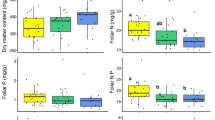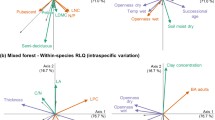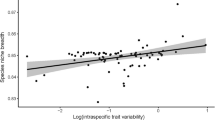Abstract
Environmental gradients are known to drive changes in mean trait values, but changes in the trait integration strength across local communities are less well understood, particularly with regard to possible links with species richness variation. Here, we tested if climate, soil, and topography gradients drive species richness indirectly via constraints on trait integration in the Atlantic Forest of South America. We evaluated seven traits (from leaf, wood, seed, and plant size) of 1456 species occurring across 84 local communities. Generalized least square models and a path model were applied to test direct and indirect relationships. Correlations were higher between leaf traits (average r = 0.28) and lower when other traits were included (average r = 0.16). In line with this result, species richness was related to a multivariate index of interspecific trait integration (ITI) computed for leaf traits, but not to the ITI for all the seven traits. Abiotic gradients influenced species richness both directly and indirectly through the leaf trait integration. A total of 33% and 26% of the variation in species richness and ITI, respectively, were explained by the models, with climatic conditions showing higher contribution than topographic and edaphic factors. These results support a significant but reduced environmental selection role behind the trait-based community assembly and may suggest that other processes are involved in the constrain of trait integration at larger spatial scales. In addition, different directional trends in trait–trait relationships across local communities suggest that global trait relationships may not necessarily hold at local contexts.




Similar content being viewed by others
Data availability
The data that support the findings of this study are available from the corresponding author upon reasonable request.
References
Adams DC, Collyer ML (2016) On the comparison of the strength of morphological integration across morphometric datasets. Int J Org Evol 70:2623–2631. https://doi.org/10.1111/evo.13045
Alvares CA, Stape JL, Sentelhas PC, de Gonçalves JL, M, Sparovek G, (2013) Koppen’s climate classification map for Brazil. Meteorol Z 22:711–728. https://doi.org/10.1127/0941-2948/2013/0507
Armbruster WS, Pelabon C, Bolstad GH, Hansen TF (2014) Integrated phenotypes: understanding trait covariation in plants and animals. Philos Trans R Soc B 369:20130245. https://doi.org/10.1098/rstb.2013.0245
Baraloto C, Paine CET, Poorter L, Beauchene J, Bonal D, Domenach AM, Hérault B, Patiño S, Roggy JC, Chave J (2010) Decoupled leaf and stem economics in rain forest trees. Ecol Lett 13:1338–1347. https://doi.org/10.1111/j.1461-0248.2010.01517.x
Bellard C, Leclerc C, Leroy B, Bakkenes M, Veloz S, Thuiller W, Courchamp F (2014) Vulnerability of biodiversity hotspots to global change. Glob Ecol Biogeogr 23:1376–1386. https://doi.org/10.1111/geb.12228
Benjamini Y, Yekutieli D (2001) The control of the false discovery rate in multiple testing under dependency. Ann Stat 29:1165–1188. https://doi.org/10.1214/aos/1013699998
Boucher FC, Thuiller W, Arnoldi C, Albert CH, Lavergne S (2013) Unravelling the architecture of functional variability in wild populations of Polygonum viviparum L. Funct Ecol 27:382–391. https://doi.org/10.1111/1365-2435.12034
Braga NS, Vitória AP, Souza GM, Barros CF, Freitas L (2016) Weak relationships between leaf phenology and isohydric and anisohydric behavior in lowland wet tropical forest trees. Biotropica 48:453–464. https://doi.org/10.1111/btp.12324
Cantidio LS, Souza AF (2019) Aridity, soil and biome stability influence plant ecoregions in the Atlantic Forest, a biodiversity hotspot in South America. Ecography (cop) 42:1887–1898. https://doi.org/10.1111/ecog.04564
Carvalho B, Bastias CC, Escudero A, Valladares F, Benavides R (2020) Intraspecific perspective of phenotypic coordination of functional traits in Scots pine. PLoS ONE 15:1–15. https://doi.org/10.1371/journal.pone.0228539
Chapin FS (1993) Evolution of suites of traits in response to environmental stress. Am Nat 142:78–92. https://doi.org/10.1086/285524
Chave J, Coomes D, Jansen S, Lewis SL, Swenson NG, Zanne AE (2009) Towards a worldwide wood economics spectrum. Ecol Lett 12:351–366. https://doi.org/10.1111/j.1461-0248.2009.01285.x
Costa-Saura JM, Trabucco A, Spano D, Mereu S (2019) A height-wood-seed axis which is preserved across climatic regions explains tree dominance in European forest communities. Plant Ecol 220:467–480. https://doi.org/10.1007/s11258-019-00928-x
Damián X, Ochoa-López S, Gaxiola A, Fornoni J, Domínguez CA (2019) Natural selection acting on integrated phenotypes: covariance among functional leaf traits increases plant fitness. New Phytol 225:546–557. https://doi.org/10.1111/nph.16116
de la Riva EG, Violle C, Pérez-Ramos IM, Marañón T, Navarro-Fernández CM, Olmo M, Villar R (2018) A multidimensional functional trait approach reveals the imprint of environmental stress in mediterranean woody communities. Ecosystems 21:248–262. https://doi.org/10.1007/s10021-017-0147-7
Delhaye G, Bauman D, Séleck M, Ilunga wa Ilunga E, Mahy G, Meerts P, (2020) Interspecific trait integration increases with environmental harshness: a case study along a metal toxicity gradient. Funct Ecol 34:1428–1437. https://doi.org/10.1111/1365-2435.13570
Díaz S, Kattge J, Cornelissen JHC, Wright IJ, Lavorel S, Dray S, Reu B, Kleyer M, Wirth C, Colin Prentice I, Garnier E, Bönisch G, Westoby M, Poorter H, Reich PB, Moles AT, Dickie J, Gillison AN, Zanne AE, Chave J, Joseph Wright S, Sheremet Ev SN, Jactel H, Baraloto C, Cerabolini B, Pierce S, Shipley B, Kirkup D, Casanoves F, Joswig JS, Günther A, Falczuk V, Rüger N, Mahecha MD, Gorné LD (2016) The global spectrum of plant form and function. Nature 529:167–171. https://doi.org/10.1038/nature16489
Dray S, Dufour AB (2007) The ade4 package: Implementing the duality diagram for ecologists. J Stat Softw 22:1–20
Dwyer JM, Laughlin DC (2017) Constraints on trait combinations explain climatic drivers of biodiversity: the importance of trait covariance in community assembly. Ecol Lett 20:872–882. https://doi.org/10.1111/ele.12781
Echeverría-Londoño S, Enquist BJ, Neves DM, Violle C, Boyle B, Kraft NJB, Maitner BS, McGill B, Peet RK, Sandel B, Smith SA, Svenning JC, Wiser SK, Kerkhoff AJ (2018) Plant functional diversity and the biogeography of biomes in North and South America. Front Ecol Evol 6:1–12. https://doi.org/10.3389/fevo.2018.00219
Flora do Brasil (2020) Instituto de Pesquisas Jardim Botanico do Rio de Janeiro. http://floradobrasil.jbrj.gov.br/
Fortunel C, Fine PVA, Baraloto C (2012) Leaf, stem and root tissue strategies across 758 Neotropical tree species. Funct Ecol 26:1153–1161. https://doi.org/10.1111/j.1365-2435.2012.02020.x
Giehl ELH, Jarenkon JA (2012) Niche conservatism and the differences in species richness at the transition of tropical and subtropical climates in South America. Ecography (cop) 35:933–943. https://doi.org/10.1111/j.1600-0587.2011.07430.x
Gonçalves ET, Souza AF (2014) Floristic variation in ecotonal areas: patterns, determinants and biogeographic origins of subtropical forests in South America. Austral Ecol 39:122–134. https://doi.org/10.1111/aec.12051
He D, Biswas SR, Xu MS, Yang TH, You WH, Yan ER (2021) The importance of intraspecific trait variability in promoting functional niche dimensionality. Ecography (cop) 44:380–390. https://doi.org/10.1111/ecog.05254
Hengl T, De Jesus JM, Heuvelink GBM, Gonzalez MR, Kilibarda M, Blagotić A, Shangguan W, Wright MN, Geng X, Bauer-Marschallinger B, Guevara MA, Vargas R, MacMillan RA, Batjes NH, Leenaars JGB, Ribeiro E, Wheeler I, Mantel S, Kempen B (2017) SoilGrids250m: Global gridded soil information based on machine learning. PLoS ONE 12:1–40. https://doi.org/10.1371/journal.pone.0169748
Hijmans RJ, Cameron SE, Parra JL, Jones PG, Jarvis A (2005) Very high resolution interpolated climate surfaces for global land areas. Int J Climatol 25:1965–1978. https://doi.org/10.1002/joc.1276
Kattge J, Díaz S, Lavorel S, Prentice IC, Leadley P, Bönisch G, Garnier E, Westoby M, Reich PB, Wright IJ, Cornelissen JHC, Violle C, Harrison SP, Van Bodegom PM, Reichstein M, Enquist BJ, Soudzilovskaia NA, Ackerly DD, Anand M, Atkin O, Bahn M, Baker TR, Baldocchi D, Bekker R, Blanco CC, Blonder B, Bond WJ, Bradstock R, Bunker DE, Casanoves F, Cavender-Bares J, Chambers JQ, Chapin FS, Chave J, Coomes D, Cornwell WK, Craine JM, Dobrin BH, Duarte L, Durka W, Elser J, Esser G, Estiarte M, Fagan WF, Fang J, Fernández-Méndez F, Fidelis A, Finegan B, Flores O, Ford H, Frank D, Freschet GT, Fyllas NM, Gallagher RV, Green WA, Gutierrez AG, Hickler T, Higgins SI, Hodgson JG, Jalili A, Jansen S, Joly CA, Kerkhoff AJ, Kirkup D, Kitajima K, Kleyer M, Klotz S, Knops JMH, Kramer K, Kühn I, Kurokawa H, Laughlin D, Lee TD, Leishman M, Lens F, Lenz T, Lewis SL, Lloyd J, Llusià J, Louault F, Ma S, Mahecha MD, Manning P, Massad T, Medlyn BE, Messier J, Moles AT, Müller SC, Nadrowski K, Naeem S, Niinemets Ü, Nöllert S, Nüske A, Ogaya R, Oleksyn J, Onipchenko VG, Onoda Y, Ordoñez J, Overbeck G, Ozinga WA, Patiño S, Paula S, Pausas JG, Peñuelas J, Phillips OL, Pillar V, Poorter H, Poorter L, Poschlod P, Prinzing A, Proulx R, Rammig A, Reinsch S, Reu B, Sack L, Salgado-Negret B, Sardans J, Shiodera S, Shipley B, Siefert A, Sosinski E, Soussana JF, Swaine E, Swenson N, Thompson K, Thornton P, Waldram M, Weiher E, White M, White S, Wright SJ, Yguel B, Zaehle S, Zanne AE, Wirth C (2011) TRY: a global database of plant traits. Glob Chang Biol 17:2905–2935. https://doi.org/10.1111/j.1365-2486.2011.02451.x
Kleyer M, Minden V (2015) Why functional ecology should consider all plant organs: an allocation-based perspective. Basic Appl Ecol 16:1–9. https://doi.org/10.1016/j.baae.2014.11.002
Lamanna C, Blonder B, Violle C, Kraft NJB, Sandel B, Símová I, Donoghue JC, Svenning J-C, McGill BJ, Boyle B, Buzzard V, Dolins S, Jorgnsen PM, Marcuse-Kubitza A, Morueta-Holme N, Peet RK, Piel WH, Regetz J, Schildhauer M, Spencer N, Thiers B, Wiser SK, Enquist BJ (2014) Functional trait space and the latitudinal diversity gradient. Proc Natl Acad Sci 111:13745–13750. https://doi.org/10.1073/pnas.1317722111
Lefcheck JS (2016) piecewiseSEM: piecewise structural equation modelling in r for ecology, evolution, and systematics. Methods Ecol Evol 7:573–579. https://doi.org/10.1111/2041-210X.12512
Li Y, Shipley B, Price J, Dantas V, Tamme R, Westoby M, Siefert A, Schamp BS, Spasojevic MJ, Jung V, Laughlin DC, Richardson SJ, Le Bagousse-Pinguet Y, Scho C, Gazol A, Prentice HC, Gross N, Overton J, Cianciaruso MV, Louault F, Kamiyama C, Nakashizuka T, Hikosaka K, Sasaki T, Katabuchi M, Frenette-Dussault C, Gaucherand S, Chen N, Vandewalle M, Batalha MA (2018) Habitat filtering determines the functional niche occupancy of plant communities worldwide. J Ecol 106:1001–1009. https://doi.org/10.1111/ijlh.12426
Maitner BS, Boyle B, Casler N, Condit R, Donoghue J, Durán SM, Guaderrama D, Hinchliff CE, Jørgensen PM, Kraft NJB, McGill B, Merow C, Morueta-Holme N, Peet RK, Sandel B, Schildhauer M, Smith SA, Svenning JC, Thiers B, Violle C, Wiser S, Enquist BJ (2018) The bien r package: a tool to access the Botanical Information and Ecology Network (BIEN) database. Methods Ecol Evol 9:373–379. https://doi.org/10.1111/2041-210X.12861
McFadden D (1974) Conditional logit analysis of qualitative choice behavior. In: Zarembka P (ed) Frontiers in econometrics, 1st edn. Academic Press, New York, pp 105-142
Méndez-Alonzo R, Paz H, Cruz R, Rosell JA, Olson ME (2016) Coordinated evolution of leaf and stem economics in tropical dry forest trees. Ecology 93:2397–2406. https://doi.org/10.2307/41739311
Messier J, McGill BJ, Enquist BJ, Lechowicz MJ (2017) Trait variation and integration across scales: is the leaf economic spectrum present at local scales? Ecography (cop) 40:685–697. https://doi.org/10.1111/ecog.02006
Michelaki C, Fyllas NM, Galanidis A, Aloupi M, Evangelou E, Arianoutsou M, Dimitrakopoulos PG (2019) An integrated phenotypic trait-network in thermo-Mediterranean vegetation describing alternative, coexisting resource-use strategies. Sci Total Environ 672:583–592. https://doi.org/10.1016/j.scitotenv.2019.04.030
Murren CJ (2002) Phenotypic integration in plants. Plant Species Biol 17:89–99. https://doi.org/10.1046/j.1442-1984.2002.00079.x
Neves D, Dexter KG, Pennington RT, Valente ASM, Bueno ML, Eisenlohr PV, Fontes MAL, Miranda PLS, Moreira SN, Rezende VL, Saiter FZ, Oliveira-Filho AT (2017) Dissecting a biodiversity hotspot: the importance of environmentally marginal habitats in the Atlantic Forest Domain of South America. Divers Distrib 23:898–909. https://doi.org/10.1111/ddi.12581
Oliveira-Filho AT, Budke JC, Eisenlohr PV, Neves DRM (2015) Delving into the variations in tree species composition and richness across South American subtropical Atlantic and Pampean forests. J Plant Ecol 8:242–260. https://doi.org/10.1093/jpe/rtt058
Pigliucci M (2003) Phenotypic integration: studying the ecology and evolution of complex phenotypes. Ecol Lett 6:265–272. https://doi.org/10.1046/j.1461-0248.2003.00428.x
Pinheiro J, Bates D, DebRoy S, Sarkar D, R Core Team (2019) nlme: Linear and nonlinear mixed effects models. R package version 3.1-141. https://CRAN.R-project.org/package=nlme.
Quan C, Han S, Utescher T, Zhang C, Liu YSC (2013) Validation of temperature-precipitation based aridity index: paleoclimatic implications. Palaeogeogr Palaeoclimatol Palaeoecol 386:86–95. https://doi.org/10.1016/j.palaeo.2013.05.008
R Core Team (2020) R foundation for statistical computing. Austria, Vienna
Read QD, Moorhead LC, Swenson NG, Bailey JK, Sanders NJ (2014) Convergent effects of elevation on functional leaf traits within and among species. Funct Ecol 28:37–45. https://doi.org/10.1111/1365-2435.12162
Rezende VL, Pontara V, Bueno ML, van den Berg E, Silva de Miranda PL, de Oliveira-Filho AT, Dexter KG (2020) Phylogenetic regionalization of tree assemblages reveals novel patterns of evolutionary affinities in the Atlantic Forest. J Biogeogr 48:798–810. https://doi.org/10.1111/jbi.14038
Rosenfield MF, Müller SC, Overbeck GE (2019) Short gradient, but distinct plant strategies: the CSR scheme applied to subtropical forests. J Veg Sci 30:984–993. https://doi.org/10.1111/jvs.12787
Scarano FR (2002) Structure, function and floristic relationships of plant communities in stressful habitats marginal to the Brazilian Atlantic Rainforest. Ann Bot 90:517–524. https://doi.org/10.1093/aob/mcf189
Scarano FR (2009) Plant communities at the periphery of the Atlantic rain forest: rare-species bias and its risks for conservation. Biol Conserv 142:1201–1208. https://doi.org/10.1016/j.biocon.2009.02.027
Shipley B (2009) Confirmatory path analysis in a generalized multilevel context. Ecology 90:363–368. https://doi.org/10.1890/08-1034.1
Silva JLA, Souza AF, Caliman A, Voigt EL, Lichston JE (2018) Weak whole-plant trait coordination in a seasonally dry South American stressful environment. Ecol Evol 8:4–12. https://doi.org/10.1002/ece3.3547
Venables WN, Ripley BD (2002) Modern applied statistics with S-Plus, 4th edn. Springer International Publishing, Berlin
Vitória AP, Alves LF, Santiago LS (2019) Atlantic forest and leaf traits: an overview. Trees Struct Funct 33:1535–1547. https://doi.org/10.1007/s00468-019-01864-z
Wright IJ, Ackerly DD, Bongers F, Harms KE, Ibarra-Manriquez G, Martinez-Ramos M, Mazer SJ, Muller-Landau HC, Paz H, Pitman NCA, Poorter L, Silman MR, Vriesendorp CF, Webb CO, Westoby M, Wright S (2007) Relationships among ecologically important dimensions of plant trait variation in seven neotropical forests. Ann Bot 99:1003–1015. https://doi.org/10.1093/aob/mcl066
Wright IJ, Falster DS, Pickup M, Westoby M (2006) Cross-species patterns in the coordination between leaf and stem traits, and their implications for plant hydraulics. Physiol Plant 127:445–456. https://doi.org/10.1111/j.1399-3054.2006.00699.x
Wright IJ, Westoby M, Reich PB, Oleksyn J, Ackerly DD, Baruch Z, Bongers F, Cavender-Bares J, Chapin T, Cornellissen JHC, Diemer M, Flexas J, Gulias J, Garnier E, Navas ML, Roumet C, Groom PK, Lamont BB, Hikosaka K, Lee T, Lee W, Lusk C, Midgley JJ, Niinemets Ü, Osada H, Poorter H, Pool P, Veneklaas EJ, Prior L, Pyankov VI, Thomas SC, Tjoelker MG, Villar R (2004) The worldwide leaf economics spectrum. Nature 428:821–827. https://doi.org/10.1038/nature02403
Zanne AE, Lopez-Gonzalez G, Coomes DAA, Ilic J, Jansen S, Lewis SLSL, Miller RBB, Swenson NGG, Wiemann MCC, Chave J (2009) Data from: towards a worldwide wood economics spectrum. Dryad Digital Repository. https://doi.org/10.5061/dryad.234
Zizka A, ter Steege H, Pessoa MDCR, Antonelli A (2017) Finding needles in the haystack: where to look for rare species in the American tropics. Ecography (cop) 41:321–330. https://doi.org/10.1111/ecog.02192
Zuur AF, Ieno EN, Walker NJ, Smith AA, Saveliev GM (2009) Mixed effects models and extensions in ecology with R. New York, USA
Funding
This work was supported by the Universidade Estadual do Norte Fluminense Darcy Ribeiro through a post-doctoral scholarship for JLAS [EDITAL ProPPG 003/2019] and by the Conselho Nacional de Desenvolvimento Científico e Tecnológico through Grants for APV [nº 302330/2019-4].
Author information
Authors and Affiliations
Contributions
JLAS, AFS, and APV conceived the ideas, the methodology, and wrote the manuscript; JS compiled and analyzed functional trait data. All authors contributed critically to the drafts and gave final approval for publication.
Corresponding author
Ethics declarations
Conflict of interest
The authors declare no conflict of interest.
Additional information
Communicated by Carissa Lyn Wonkka.
Publisher's Note
Springer Nature remains neutral with regard to jurisdictional claims in published maps and institutional affiliations.
Supplementary Information
Below is the link to the electronic supplementary material.
Rights and permissions
About this article
Cite this article
Silva, J.L.A., Souza, A.F. & Vitória, A.P. Leaf trait integration mediates species richness variation in a species-rich neotropical forest domain. Plant Ecol 222, 1183–1195 (2021). https://doi.org/10.1007/s11258-021-01169-7
Received:
Accepted:
Published:
Issue Date:
DOI: https://doi.org/10.1007/s11258-021-01169-7




